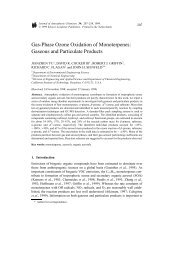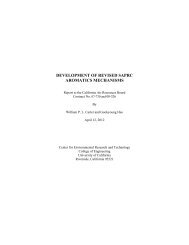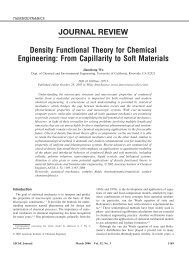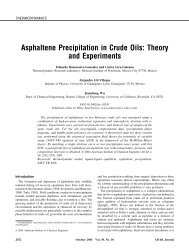State-of-the-Art Chamber Facility for Studying Atmospheric Aerosol ...
State-of-the-Art Chamber Facility for Studying Atmospheric Aerosol ...
State-of-the-Art Chamber Facility for Studying Atmospheric Aerosol ...
You also want an ePaper? Increase the reach of your titles
YUMPU automatically turns print PDFs into web optimized ePapers that Google loves.
FIGURE 8. Sample TDMA size distribution spectrum. Left curve is<br />
output <strong>of</strong> second DMA <strong>for</strong> dry (NH 4) 2SO 4 seed particles classified<br />
to 136 nm by first DMA at RH ) 0%. Right curve is output <strong>of</strong> second<br />
DMA <strong>for</strong> dry (NH 4) 2SO 4 seed particles classified to 136 nm by first<br />
DMA at RH ) 85%.<br />
<strong>Aerosol</strong> Formation and Evolution Experiments<br />
In <strong>the</strong> absence <strong>of</strong> seed particles, aerosol may <strong>for</strong>m by<br />
homogeneous nucleation. The number <strong>of</strong> particles that<br />
results depends strongly upon <strong>the</strong> operating conditions.<br />
Moreover, <strong>the</strong> concentration is uncertain since nucleation<br />
produces particles that are, at least initially, too small to<br />
detect. For quantitative measurements <strong>of</strong> aerosol yield, we<br />
<strong>the</strong>re<strong>for</strong>e turn to seeded chamber studies. As described below,<br />
<strong>the</strong> aerosol yield varies depending on whe<strong>the</strong>r <strong>the</strong> seed<br />
particles are dry or not.<br />
Dry Nucleation. In experiments per<strong>for</strong>med without seed<br />
particles and at low relative humidity, aerosol <strong>for</strong>ms when<br />
a gas-phase organic product accumulates to a sufficient<br />
supersaturation to induce homogeneous nucleation. Condensation<br />
and subsequent absorption <strong>of</strong> oxidation products<br />
leads to particles that are 100% organic in composition. The<br />
quantity <strong>of</strong> aerosol produced in this case, estimated from<br />
<strong>the</strong> final aerosol volume after accounting <strong>for</strong> wall losses,<br />
provides a measure <strong>of</strong> <strong>the</strong> SOA <strong>for</strong>mation potential in a clean,<br />
dry environment. TDMA measurements <strong>of</strong> <strong>the</strong> chamber<br />
aerosol produced in <strong>the</strong> absence <strong>of</strong> seed particles reveals <strong>the</strong><br />
hygroscopic nature <strong>of</strong> <strong>the</strong> pure organic oxidation products.<br />
Humid Nucleation. In experiments per<strong>for</strong>med at elevated<br />
RH, but without seed particles, aerosol also <strong>for</strong>ms by<br />
nucleation, but subsequent particle growth involves partitioning<br />
<strong>of</strong> both water and organic products into <strong>the</strong> aerosol.<br />
Used in conjunction with a dry nucleation experiment, <strong>the</strong><br />
humid nucleation experiment allows one to explore <strong>the</strong> effects<br />
<strong>of</strong> <strong>the</strong> presence <strong>of</strong> water on gas-particle conversion. The SOA<br />
yield <strong>of</strong> <strong>the</strong> wet nucleation experiments can be corrected <strong>for</strong><br />
water uptake by estimating <strong>the</strong> water fraction as that obtained<br />
from TDMA analysis <strong>of</strong> dry nucleation particles. The SOA<br />
yield in <strong>the</strong> humid system can be calculated and compared<br />
to <strong>the</strong> dry nucleation experiments after accounting <strong>for</strong> wall<br />
losses.<br />
Dry Seed, Dry Conditions. In experiments per<strong>for</strong>med with<br />
sufficiently high concentrations <strong>of</strong> water-free inorganic seed<br />
particles in a dry chamber, <strong>the</strong> seed particles suppress<br />
nucleation and ensure that <strong>the</strong> chamber aerosol lies within<br />
<strong>the</strong> size range <strong>of</strong> <strong>the</strong> instrumentation throughout <strong>the</strong><br />
experiment. SOA production commences when a sufficient<br />
supersaturation <strong>of</strong> oxidation products accumulates to induce<br />
<strong>the</strong> condensation onto <strong>the</strong> dry seed surface producing an<br />
initial organic layer. Fur<strong>the</strong>r aerosol growth occurs by<br />
absorption <strong>of</strong> reaction products into <strong>the</strong> organic layer. The<br />
resulting aerosol contains both inorganic and organic species.<br />
With a nonvolatile seed aerosol, <strong>the</strong> total suspended inorganic<br />
aerosol volume changes only by particle depositions onto<br />
<strong>the</strong> chamber walls. There<strong>for</strong>e, <strong>the</strong> organic aerosol yield can<br />
be computed from <strong>the</strong> total aerosol produced less <strong>the</strong> initial<br />
amount <strong>of</strong> inorganic material present after correction <strong>for</strong><br />
wall losses. Comparison <strong>of</strong> <strong>the</strong> results <strong>of</strong> <strong>the</strong>se experiments<br />
to those <strong>of</strong> dry nucleation experiments allows one to estimate<br />
<strong>the</strong> influence <strong>of</strong> a dry, inert nonreactive surface on gas-particle<br />
partitioning.<br />
Dry Seed, Elevated Relative Humidity. These experiments<br />
add <strong>the</strong> influence <strong>of</strong> water vapor to <strong>the</strong> previous experiments.<br />
To keep <strong>the</strong> seed particles dry, <strong>the</strong> RH in <strong>the</strong>se experiments<br />
cannot exceed <strong>the</strong> deliquescence RH <strong>of</strong> <strong>the</strong> inorganic salt<br />
comprising <strong>the</strong> seed particles. <strong>Aerosol</strong> growth takes place<br />
when a sufficient supersaturation <strong>of</strong> oxidation products leads<br />
to <strong>the</strong> production <strong>of</strong> an initial organic layer. Fur<strong>the</strong>r aerosol<br />
growth occurs as water and organic material partition into<br />
<strong>the</strong> organic or organic-water phase. The resulting aerosol<br />
contains inorganic material, organic material, and, possibly,<br />
water. Several investigations have noted that <strong>the</strong> deliquescence<br />
RH <strong>of</strong> <strong>the</strong> inorganic salt is unperturbed by organic<br />
coatings (7). If, <strong>the</strong>re<strong>for</strong>e, <strong>the</strong> inorganic core <strong>of</strong> <strong>the</strong> aerosol<br />
remains dry, SOA yield can be measured as <strong>the</strong> final aerosol<br />
volume less <strong>the</strong> initial seed volume and water content (all<br />
corrected <strong>for</strong> wall losses). Water content is again measured<br />
independently by TDMA analysis ei<strong>the</strong>r using dry aerosol<br />
from dry nucleation or from dry seed, low RH experiments.<br />
Care must be taken to ensure that <strong>the</strong> aerosol is dry when<br />
injected and is never exposed to RH higher than <strong>the</strong> particle<br />
deliquescence RH. The state <strong>of</strong> <strong>the</strong> seed aerosol is verified<br />
prior to <strong>the</strong> start <strong>of</strong> an experiment through TDMA analysis<br />
at an RH above <strong>the</strong> seed deliquescence RH. A G f value lower<br />
than that <strong>for</strong> a dry seed aerosol indicates that <strong>the</strong> seed is not<br />
dry.<br />
Aqueous Seed, Elevated Relative Humidity. In this case,<br />
experiments are per<strong>for</strong>med at elevated RH with deliquesced<br />
(wet) seed aerosol. Generation <strong>of</strong> such aerosol requires that<br />
at no point does <strong>the</strong> RH surrounding <strong>the</strong> aerosol drop below<br />
its efflorescence RH. The state <strong>of</strong> <strong>the</strong> aerosol can be verified<br />
by TDMA measurements <strong>of</strong> <strong>the</strong> hygroscopic growth factor<br />
<strong>of</strong> <strong>the</strong> particles. The water content <strong>of</strong> <strong>the</strong> inorganic seed can<br />
be estimated based on <strong>the</strong>rmodynamic <strong>the</strong>ory (8). Oxidation<br />
products may partition into <strong>the</strong> aqueous phase or into a<br />
separate organic phase. The amount <strong>of</strong> water in <strong>the</strong> aerosol<br />
may ei<strong>the</strong>r increase or decrease during growth. Because <strong>the</strong><br />
final aerosol water content cannot be independently determined,<br />
<strong>the</strong> total aerosol yield, including water and organic<br />
material, is reported.<br />
<strong>Aerosol</strong> Dynamics<br />
A major goal <strong>of</strong> <strong>the</strong> aerosol chamber experiments we have<br />
described is to determine <strong>the</strong> aerosol <strong>for</strong>mation potential <strong>of</strong><br />
ei<strong>the</strong>r a single compound or a mixture. To do this, one must<br />
estimate <strong>the</strong> mass <strong>of</strong> aerosol produced over <strong>the</strong> course <strong>of</strong> an<br />
experiment. Figure 9 shows a typical set <strong>of</strong> data, including<br />
<strong>the</strong> hydrocarbon disappearance, <strong>the</strong> amount <strong>of</strong> suspended<br />
aerosol volume, and <strong>the</strong> number distribution <strong>of</strong> particles.<br />
The reaction is considered finished when <strong>the</strong> aerosol volume<br />
(corrected <strong>for</strong> wall processes) is no longer changing. Several<br />
microphysical processes occurring in <strong>the</strong> chamber must be<br />
considered in order to estimate <strong>the</strong> amount <strong>of</strong> organic aerosol<br />
produced (9).<br />
The principal process that complicates <strong>the</strong> interpretation<br />
<strong>of</strong> measured aerosol data is loss <strong>of</strong> particles to <strong>the</strong> wall <strong>of</strong> <strong>the</strong><br />
chamber. To determine <strong>the</strong> total amount <strong>of</strong> aerosol mass<br />
generated, one must estimate <strong>the</strong> quantity <strong>of</strong> <strong>the</strong> aerosol lost<br />
to <strong>the</strong> chamber walls over <strong>the</strong> course <strong>of</strong> <strong>the</strong> experiment and<br />
add that to that measured <strong>of</strong> <strong>the</strong> end <strong>of</strong> <strong>the</strong> run. Particles<br />
deposit on <strong>the</strong> wall at a rate that is proportional to <strong>the</strong> particle<br />
concentrations and depends on particle size, leading to first-<br />
VOL. 35, NO. 12, 2001 / ENVIRONMENTAL SCIENCE & TECHNOLOGY 9 2599
















